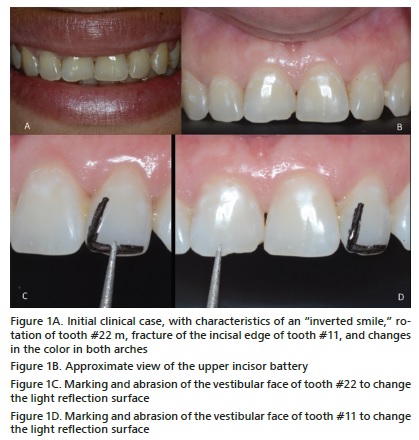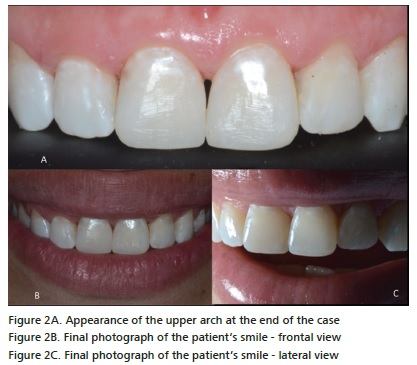Serviços Personalizados
Artigo
Links relacionados
Compartilhar
Revista Brasileira de Odontologia
versão On-line ISSN 1984-3747versão impressa ISSN 0034-7272
Rev. Bras. Odontol. vol.73 no.3 Rio de Janeiro Jul./Set. 2016
SHORT COMMUNICATION/DENTISTRY
Cosmetic contour: minimally invasive cosmetic reformulation
Cínthia Marques SperdutoI; Letícia Chaves DavidI; Thaíssa de Barros A. PiresI; Bruna C. Tomé BarretoI; Denise Fernandes Lopez NascimentoI; Gisele Damiana S. PereiraI
I Department of Clinics, School of Dentistry, Federal University of Rio de Janeiro, Rio de Janeiro, Brasil
ABSTRACT
Objective: This study aimed to describe a clinical case in which cosmetic contouring was used and to describe that technique's advantages and limitations. Case Report: Cosmetic contouring was applied to a female patient who presented with rotation of maxillary left lateral incisor, and concave and fractured edges of the upper central incisors, creating an impression of an "inverted smile." A slight abrasion was performed to change the inclination of those teeth, and restoration with composites complemented esthetics by reconstituting the contour and shape. Conclusion: Cosmetic contouring can be an effective technique to correct changes in tooth shape and positioning.
Keywords: Dental esthetics; Dental resins; Tooth lightening.
Introduction
The quest for a harmonious smile is evidently increasing; dental esthetics is related to an individual's self-esteem and has become a significant factor in determining one's social relations and integration into the labor market.1
Dental anomalies are among the factors that may interfere with dental esthetics. They can be classified into anomalies of the number, size, structure, and shape.1 A special mention should be made of the shape or contour changes commonly encountered in clinical practice, such as conoid or rotated teeth and diastemas, which directly interfere in the correct positioning of the teeth in the dental arch.2
The progress of adhesive dentistry has made possible the composition of direct restorations solely for esthetic purposes, with only very little abrasion of the tooth structure.3 In this regard, one should mention nanoparticle-reinforced resins, which have excellent physical, mechanical, and optical properties and, therefore, conclude that the evolution of available materials and the improvement of surgical techniques have given highly significant and favorable results in the quest for self-image.4
Under the principle of minimally invasive dentistry, cosmetic contouring appeared as a technique for dental remodeling by an optical illusion, by reduction of dental angles, or by the addition of resin.5,6 In other words, changes are made to areas that reflect or disperse light, thereby correcting the proportion and alignment of the teeth for improvement of the smile.
The concept of esthetics works on subjective components to create a perception of harmony and beauty. Therefore, there are two main goals, namely execution of the technique in such a way that the dimensions of the tooth are pleasant to other persons and to oneself, and to make the tooth occupy a balanced position in relation to the lips and other facial structures. Additionally, in cosmetic treatments, the dental surgeon must have knowledge of such esthetic principles as the mesiodistal diameter of the teeth, esthetic dental proportion, contour of the gums, interdental contact and spacing, and smile line.6
Although the dental contouring technique still has some limitations, it offers several advantages, such as bringing back function, esthetics, and personal characteristics of the individual. Its main advantage, however, is that it is a conservative technique that limits itself to minimal tooth abrasion.5
This study aimed to discuss the advantages and limitations of using the technique of cosmetic contouring and to describe the case of a patient with tooth rotation, inverted smile, and changes in color and in the mesiodistal distance of the upper incisor battery who underwent cosmetic remodeling of the smile based on principles of optical illusion, with minimal tooth abrasion and the addition of composite resin.
Case report
A 29-year-old woman reported to the Integrated Clinic of the Faculty of Dentistry of the Federal University of Rio de Janeiro complaining of a disharmonious smile. On clinical examination, rotation of tooth left lateral superior incisor was observed, as well as a concave edge of the central incisors in relation to the lower lip, creating an impression of an "inverted smile." The incisal edge of maxillary right central incisor was also fractured, and there were changes in color and in the mesiodistal distance of the upper incisor battery (Figure 1A).
After preparation of the oral environment, a tooth lightening plate for home use was crafted and given to the patient, along with FGM Whiteness Perfect 10% lightening gel (carbamide peroxide; FGM Dental Products, Joinville, Brazil). The patient was advised to use the plate for 4 hours daily for 4 weeks. In Figure 1B, an approximate view of the upper incisor battery, a lighter color can be seen. Fifteen days after the lightening treatment (so that all the residual oxygen was released), the esthetic part of the treatment plan was started, and cosmetic contouring was chosen.
The vestibular faces of maxillary right and left central incisors were slightly abraded with a KG 2200 drill (KG Sorensen, Cotia, Brazil), in order to cause changes in areas where light is reflected (Figure 1C and 1D). After absolute isolation with a rubber sheet, the final restoration of those teeth was started, using the adhesive technique with FGM Opallis composite (FGM Dental Products, Joinville, Brazil). Translucent resin was applied to the palatine region, opaque resin to the incisal region, and resin in the colors A2 and D2 to the vestibular region by the stratification method, thereby improving the "inverted smile" appearance. A2 resin was also added to the mesiovestibular region of maxillary left lateral incisor to correct its rotation. After 1 week, the restorations were finished and polished (Figure 2A, 2B, and 2C).


Discussion
Achieving beauty is part of worldwide culture, and it could not be any different in dentistry, as the esthetics of the smile has been a great motivation for seeking dental treatment.3
In modern society, esthetics and youth are strongly associated and intertwined. A few esthetic features have been emphasized, such as a greater exposure of the central upper incisors, which has been associated with youth, sensuality, and sexual attractiveness.6
In this regard, it can be said that changes in tooth positioning or shape, such as diastemas, conoid or rotated teeth, as well as changes in color, texture, or tooth alignment within the arch, compromise tooth harmony.1
The evolution of restoration materials and adhesive systems has been a contributing factor to the resolution of esthetic problems. By using micromechanical retention in dental structures prepared with an acid treatment, and with the appearance of so-called composite resins, an increasing evolution could be seen in the clinical possibilities of said materials.7
Composite resins are widely used in the direct restoration of both anterior and posterior teeth for their esthetic, physical, and mechanical properties.8 A logical sequence making use of various technical possibilities is desirable, particularly as a way of making the reconstructing process of anterior teeth predictable.7
The current esthetic characteristics of composite resins and a better understanding of the behavior of dental tissues under light allow an imperceptible restoration to be performed. It is fundamental to have an exact knowledge of the translucence and colors of the materials used.9 The insertion of resins of different colors must be done with a technique that allows for the separate restoration of enamel and dentin. This incremental approach allows for a perfect masking of the limits between tooth and restoration, and for a more precise reproduction of the optical, physical, and mechanical characteristics of each dental substrate.10
In cosmetic contouring, it is paramount that the clinician is trained to observe fundamental aspects and details for an adequate planning and execution of a correct esthetic restoration treatment. Aesthetic aspects comprise the main optical characteristics of composites: color, opaqueness/ translucence, opalescence, and fluorescence. The professional must have basic notions of color, and must understand the concepts of hue, chroma, and value.10
As a general rule, translucent resins work as an artificial enamel, whereas opaque resins work as an artificial dentin. From this perspective, one must determine the area where each type of composite resin will be applied, according to its mechanical and optical behavior characteristics, as well as the thickness of the layers, in order to maximize the esthetic results.7
Surface texture is also very relevant in the final esthetic appearance of the restoration. It is very closely related to color, and not only is it felt, but it can also be optically evaluated from the amount of light that is either reflected or deflected, so that the difference between a smooth and a rough surface can be perceived. This characterization is obtained from the contrast of convex and concave areas.10
Finally, the integration of the restoration to the patient's gums, lips, smile, and face is fundamental for the esthetic success of the restoration procedure. The size of a tooth is relevant not only for its own esthetics, but also for the esthetics of the face. The teeth must be in proportion to one another, but they must also be in proportion to the face, because a large variation in the size of a tooth relative to the face may adversely affect the chances of obtaining an optimal esthetic result.5
All these parameters are important when performing a dental contouring, allowing for a complete balance between the analyzed structures and the teeth and for a successful esthetic treatment.
Conclusion
One may conclude that, for the esthetic restoration of the smile, small changes in positioning and shape can be corrected by cosmetic contouring, by a minimally invasive reshaping of the teeth, with minimal abrasion of the natural tooth structure. Its association with the use of different composite resins to achieve characterizations and optical effects make it possible and easier to mimic dental tissue, restoring the shape and esthetics in a natural way.
References
1. Pini NIP, Khoury EMDA, Pascotto RC. Tratamento interdisciplinar para reabilitação estética do sorriso. Rev Dental Press Estét. 2010;7(2):40-50. [ Links ]
2. Oliveira DCRS, Pietro LT, Coppini EK, Araújo CTP, Souza-Junior E, Paulillo LAMS. Resolução estética: fechamento de diastemas e contorno cosmetic. Prosthes. Lab. Sci. 2014;3(10):107-13.
3. Costa SXS, Becker AB, Rastelli ANS, Andrade MF. Contorno Cosmético com Resina Composta Nanoparticulada: Relato de Caso Clínico. Rev Dental Press Estét. 2007;4(3):24-33.
4. Costa CP, Gratone JM, Ferreira PM, Ribeiro TC. Odontologia estética integrada: a busca do equilíbrio. Rev Dent Press Estét. 2005;2(4):58-74.
5. Kreia TB, Takana O, Meda EM, Vieira AS. Dentística restauradora e a ortodontia no estabelecimento da estética anterior. J Bras Clín Odontol Integr. 2003;2(6):158-65. Referências ::
6. Machado AW. Ten commandments of smile esthetics. Dental Press J Orthod. 2014;19(4):136-57.
7. Hirata R, Ampessan RL, Liu J. Reconstrução de dentes anteriores com resinas compostas: uma sequência de escolha e aplicação de resinas. J Bras Clín Odonto Integr. 2001;5(25):15-25.
8. Guler AU, Duran I, Yucel AÇ, Ozkan P. Effect of air-polishing powders on color stability of composite resins. J Apll Sci. 2011;19(5):505-10.
9. Furuse AT, Baratto SS, Spina DR, Correr GM, Cunha LF, Gonzaga CC. Planning extensive esthetic restorations for anterior teeth: Use of waxedup study casts and composite resin mock-ups. Gen-dent. 2016;64(1):6-9.
10. Nahsan FPS, Mondelli RFL, Franco EB, Naufel FS. Clinical strategies for esthetic excellence in anterior tooth restorations: Understanding color and composite resin selection. J Appl Sci. 2012;20(2):151-6.
 Endereço para correspondência:
Endereço para correspondência:
Gisele Damiana da Silveira Pereira
e-mail: giseledamiana@yahoo.com
Submitted: 07/11/2016
Accepted: 07/22/2016













